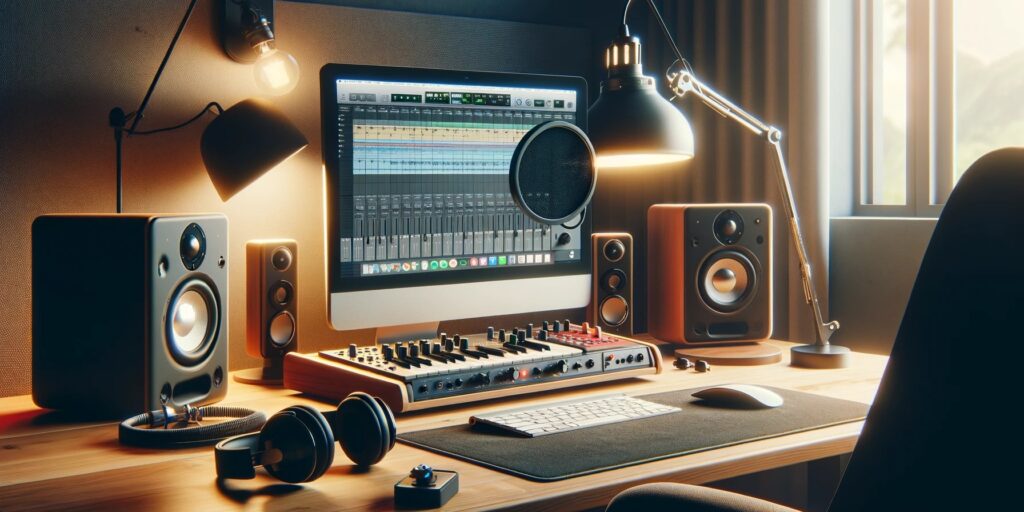(And other aspiring musical artists)

We participate in various affiliate marketing programs, which means we may get paid commissions on editorially chosen products purchased through our links to retailer sites.
Navigating the labyrinth of home recording is kind of like trying to assemble IKEA furniture while blindfolded, except instead of ending up with a lopsided bookshelf, you might just produce the next big hit… or a collection of sounds reminiscent of a cat walking on a piano. This guide is here to help you, the aspiring audio alchemist, to not only find your way through the maze but maybe end up with something that sounds more like music and less like a dumpster fire.
The Must-Haves for Your Home Studio
Microphones: Picking a microphone is a bit like dating in your 30s. You’ve got to know what you want, and you can’t be fooled by looks alone. The Shure SM57 and SM58 are like the reliable, sturdy partners you wish you’d met earlier—great at their job, no unnecessary frills, and they won’t fall apart on you after two weeks.
Audio Interfaces: The Focusrite Scarlett 2i2 is essentially the bridge over troubled water between your instruments and your computer. It’s the unsung hero that makes sure your guitar’s soliloquy doesn’t turn into digital gibberish. If your music was a pizza, the audio interface is the guy making sure it gets to your house still hot and crispy, not squished and cold. It won’t break the bank, but gets the job done.
Studio Monitors and Headphones: Trying to mix your tracks without decent monitors or headphones is like cooking without tasting—sure, you might end up with something edible, but you’re just as likely to end up with a salt mountain. My preference would be something like the KRK Rokit Series or Yamaha HS series. Both come in different sizes with different price ranges. A solid pair of headphones like the Sennheiser HD280 Pro will save you from making a track that sounds great in your bedroom but like a carnival ride from hell everywhere else.
Computer: You need a computer that doesn’t wheeze and die on you the moment you ask it to handle more than a Google search. Something with at least 8GB of RAM and a processor that’s not from the Stone Age. Also, a good graphics/sound card is absolutely essential. Think of it as the difference between riding a scooter and a sports bike; both will get you there, but one’s going to make it a lot more fun. If you have the budget most professionals will tell you to go with Apple. However, if you need something on a budget, the Asus Vivobook 16 is highly rated for it’s class.
The Holy Grails of Recording Kits
Picking a kitis like hitting the buffet. You want to get the most bang for your buck without ending up with a plate full of stuff you don’t actually like. But if you’re an absolute beginner, or you just don’t want to spend forever sorting through individual options, this may be the way to go for you.
- Mackie Studio Bundle: This is the all-you-can-eat option. If you’re the type who wants to try a little bit of everything, this will keep you busy and then some.
- Audient Evo Start Recording Bundle: For those on a budget who still want quality, this is like finding a hidden gourmet meal at a fast-food price.
- PreSonus Audiobox 96: This is the fine dining of recording bundles. You’re paying more, but for a sound that’s like butter, it might just be worth it.
Setting Up Your Recording Studio Kingdom
Room Treatment: Making your room soundproof is a bit like trying to explain the internet to your grandparents. It might seem simple in theory, but in practice, it’s a whole thing. Bass traps and acoustic panels are your friends here, making sure your killer solo doesn’t echo like you’re in the Grand Canyon.
Furniture and Ergonomics: You’re going to spend a lot of time in this space, so make it comfortable. Don’t skimp on a good chair unless you fancy turning into Quasimodo. And get a desk that fits your gear, or you’ll be playing keyboard Tetris instead of recording music. I recommend something like the Armocity Music Studio Desk. It has power outlets and LED lighting, which is nice. If you’re going to be recording on video, you’ll want good lighting also.
Cable Management: Let’s be honest, nobody likes doing it, but managing your cables is like flossing. Ignore it, and things get ugly fast. A few cable ties can prevent your studio from looking like a robot threw up.
Choosing Your DAW
Picking a Digital Audio Workstation is like choosing a favorite child. They’ve all got their quirks, but deep down, you know you prefer one over the others. Whether it’s the user-friendly GarageBand or the powerhouse that is Pro Tools, go with what feels right. After all, you’re going to be spending a lot of late nights together. GarageBand is a popular option if you have a Macbook as it comes with it. However, if budget isn’t an issue, you can pick up a much more comprehensive and versatile option with the Pro Tools.
Wrapping It Up
Building a home studio is a journey—a sometimes frustrating, occasionally bewildering, but ultimately rewarding quest. It’s about finding the right tools, yes, but also about making a ton of mistakes and learning as you go. And remember, even the greatest musicians started somewhere, probably in a room not much bigger than yours, wondering why their recording sounds like it was done in a kitchen. Here’s to making noise that, hopefully, turns into music.
2 thoughts on “Home Recording Studio for Beginner Classical Guitarists”